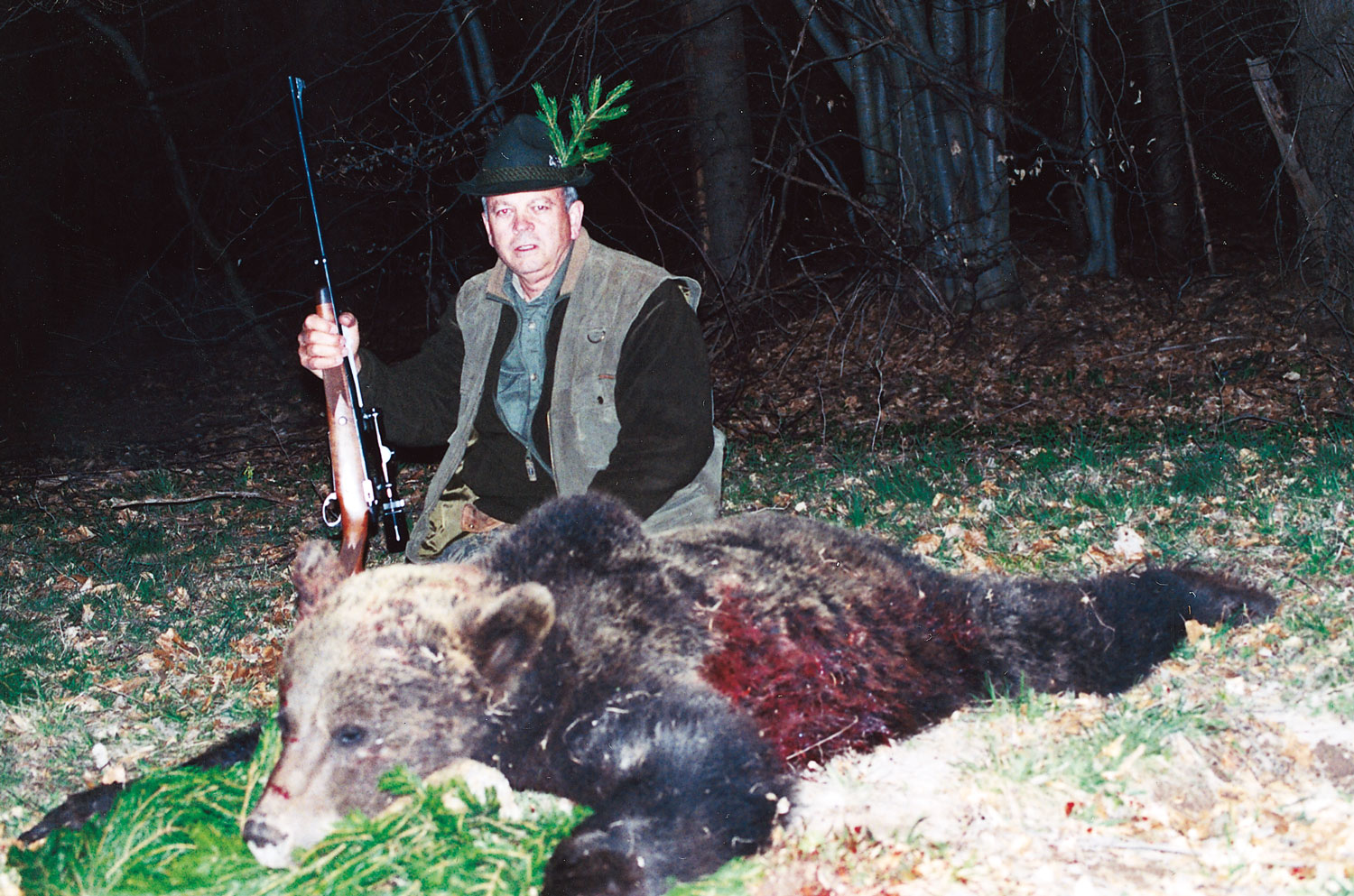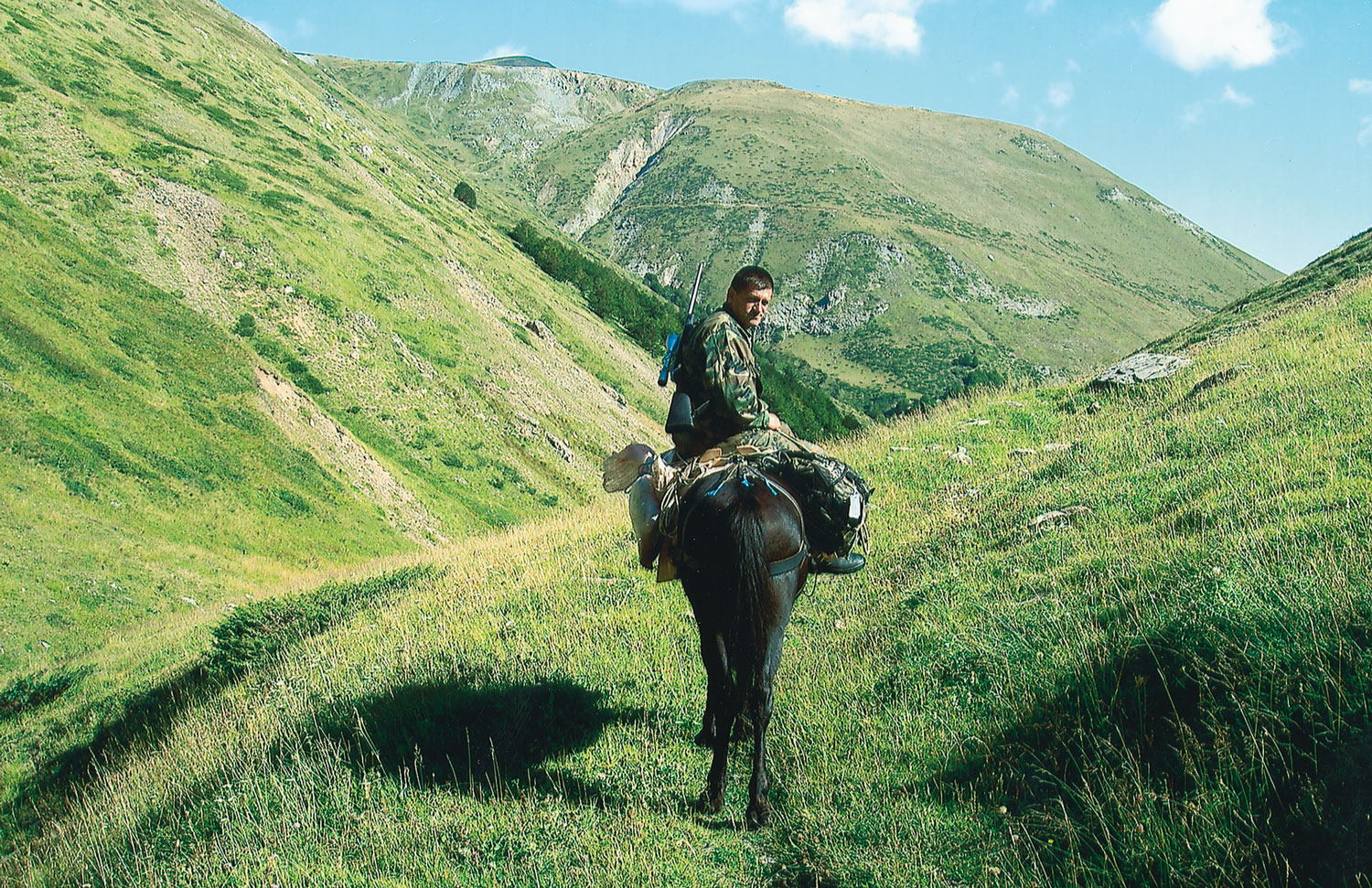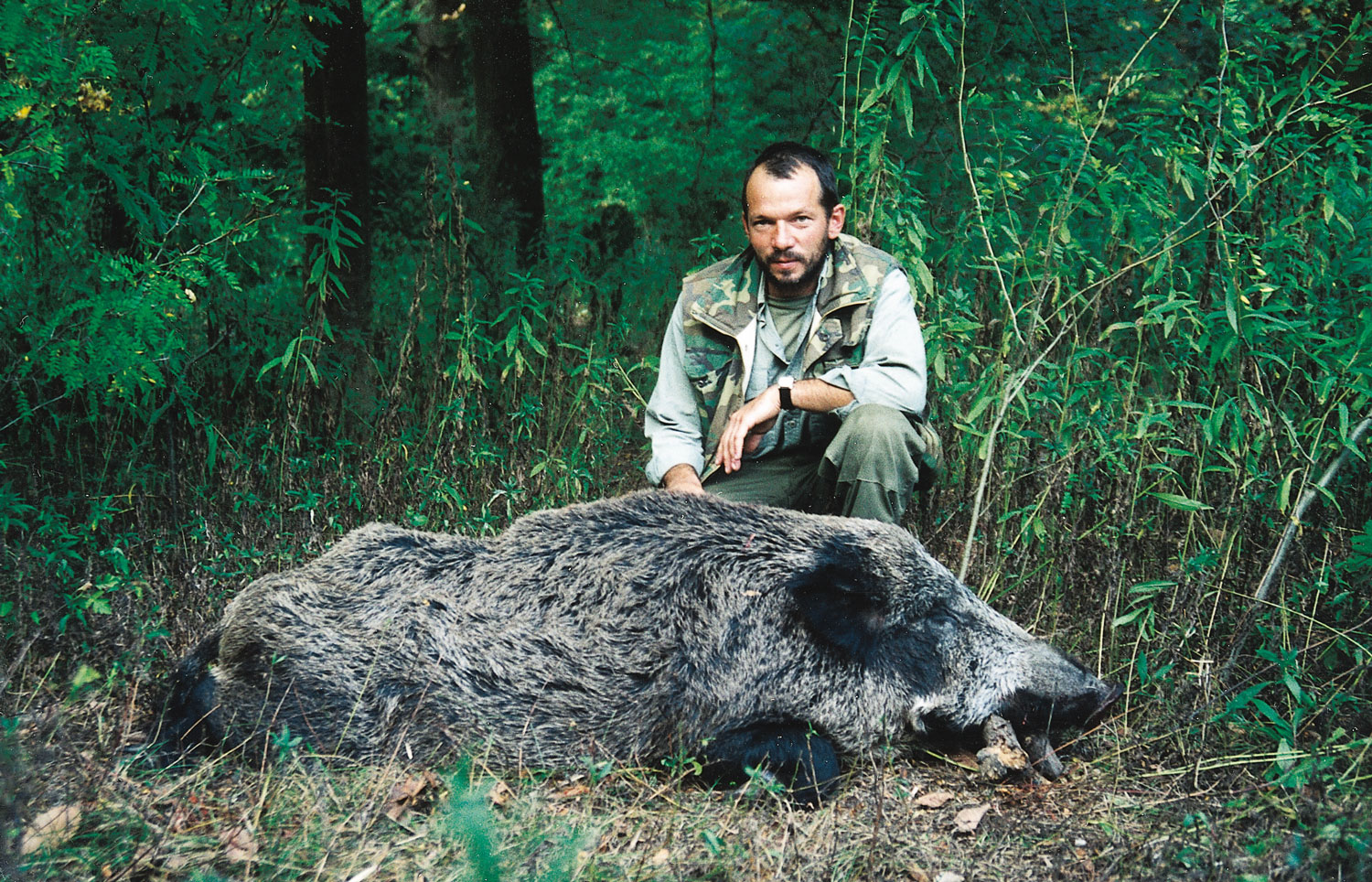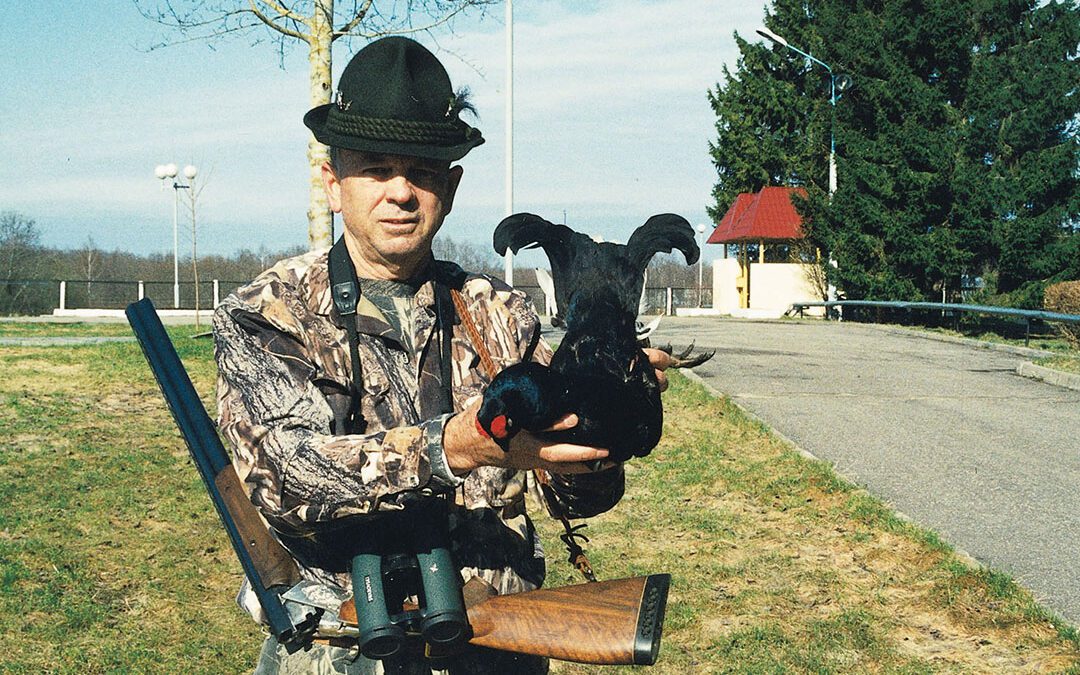Our forced march was exhausting, and I was cold, wet and miserable. For nearly an hour we’d been trudging across a heath bog in eastern Europe, trying to reach the blind before daylight. It was like walking on a six-inch mattress floating in a foot of water. I’d hunted on trembling earth like this as a kid growing up near the Okefenokee Swamp, but then I was young and fearless. Now I’m old and don’t like being cold and wet. The moonlight revealed an alien environment – it might as well have been moonscape. We were in the middle of a vast, short-grass marsh studded with small tussocks and layered with lichens, mosses and dwarf berry bushes.
Finally, Vladimir’s spotlight revealed a small blind dressed with foliage to resemble a large tussock. There was a bench inside, a dry place to rest and await the dawn, which was fast approaching.
We were in Belarus, in one of its ten zillion heath marshes, all home to the black grouse, one of the most magnificent gamebirds in the world. The only question was: Would they appear at dawn?
For centuries czars and kings, lords and peasants have roamed the forests of eastern Europe in pursuit of food and sport. This beautiful region, though rich in game, was yet to be discovered by American hunters.
The end of World War II marked a period of global expansion by the North American sporthunter, but political ramifications prevented travel in much of eastern Europe. Most countries had suffered under the grip of communist dictators for four decades. Then, in 1989 Poland declared free elections and like collapsing dominoes, most of eastern Europe followed suit. Nicolae Ceausescu of Romania was executed on Christmas Day, 1989, and Bulgaria’s Zhivkov resigned the same year. Hungary had its first democratic election in 1990 and Belarus declared full national independence in 1991. The Soviet Union was history, and changes in the region’s political structure, along with a strong desire to join the free world, came rapidly.
The doors were thrown open to foreign hunters, but they were slow to respond. After 40 years of isolation, there were bound to be questions as to game populations, importation of firearms and hunting fees.
In recent years I’ve hunted every eastern European country, from Estonia south to Bulgaria. I’ve discovered a wonderful cornucopia of sporting opportunities, surprisingly relaxed regulations regarding firearms importation, and much lower hunting fees than found in western and central Europe. Best of all, the eastern Europeans love Americans and welcome hunters.
My greatest surprise, however, was the abundance of game. One rare benefit of the dictatorships was the explosion of game populations. Most of the communist rulers declared wild game to be the property of the government, which usually meant for their personal and exclusive use. Since no one else could hunt, game numbers rebounded to all-time high levels.
While all 12 of the eastern European countries offer wonderful hunting, I have selected five where I enjoyed hunts that were especially interesting and memorable.
BELARUS
So here I was in the middle of a thousand acres of heath marsh, hoping a blackcock would appear. Vladimir, my guide, tipped his head as though listening intently. In the distance we heard a soft, fluted call. A minute later we heard another, then a set of fast wingbeats right over the blind. As dawn cracked we could hear more wingbeats and the mating calls of strutting blackcocks wafting across the marsh, a sort of oloo-oloo-oloo-oloo – incessant but never changing in pitch. There must have been several dozen birds within a hundred yards of the blind.
As the light improved, I began to pick them up in my binoculars. When I caught the first solar rays against a displaying cock, I thought I had never seen anything so fine. The swollen red comb over each eye was in stark contrast to its iridescent, blue-black plumage.
Suddenly there was a loud set of wingbeats just over the blind. A cock landed 35 yards in front of my shooting window and instantly began to piroutte. He thrust his head forward and fanned his tail, which was framed by black, lyre-shaped feathers. The instant I eased my over-under out the opening, he erupted into the air, but the load of number 4s caught him just a few feet off the ground and he fell fluttering to the heath.
After admiring the blackcock’s beautiful plumage, Vladimir placed the traditional spruce tip in the bird’s mouth and another in my hat. Lady luck is fickle and success seems to sometimes come from nowhere, but it’s much better received when it’s well earned. I had paid for this one with years of waiting, a long flight and an exhausting trek across the bog.
Belarus is one of the few countries where you can hunt blackcock in the spring, and maybe the only country where so many can be observed on their lekking grounds. Altogether it was a unique and absolutely unforgettable experience.
Several days later I enjoyed a successful hunt for capercaillie in a beautiful pine and fir forest in northern Belarus and hot action on late-afternoon flights of woodcock.
In the fall Vladimir offers hunting for red stag, roe deer, Russian boar, moose and wolf. Belarus is one of the few countries where visiting hunters can take European bison.
Our meals and accommodations were excellent. Your guide will arrange an interpreter as very few Belarusians speak English other than the staffs at hotels and restaurants in Minsk, the nation’s capital.
If you want to go, contact Jerome Knap at www.globalexpeditions.ca or email mailto:cnonorth@istar.ca.

The author shot this big male bear from the same high-seat used by former Romanian dictator Nicolae Ceausescu.
POLAND
The rain finally stopped as we approached the meadow where the red stag had been roaring since early that morning. Now it was late afternoon and my last chance for taking a stag in Debrowa Tarnowska National Forest east of Cracow. We had been hunting for four days with Daniel Lemarteleur of International Sporting Travel. We’d hit the rut square on and bulls were roaring everywhere.
Daniel took a great stag early in our hunt, and while I had enjoyed several thrilling stalks, something had gone wrong each time. Usually the culprit was a squirrelly wind that sent the stag crashing off through the old-growth forest.
My guide, Marek, and I entered the meadow about an hour before dark and sat down on a grassy knoll. Hopefully the stag would roar again before dark. Two roe deer fed into the meadow, but that was it during the first half-hour. Then a lone stag roared in the forest about 200 yards off to our left. Marek looked at me and grinned as he raised his horn. He issued a long moan that sounded as if some great beast was dying, following by five short grunts. He put the horn down and picked up his binoculars. I could tell he wouldn’t call again. It was now or never.
As darkness approached, I resigned myself to the likelihood that I would leave Poland empty-handed.
Then Marek whispered, “Stag, shoot.”
It was difficult to find the stag in my scope, but I finally found him, facing us at 150 yards. I squeezed the trigger, heard the thump, and almost before I could recover from the shot Marek was clapping me on the back and laughing loudly. It was truly a last-second stag.
Poland offers excellent hunting for red stag, in addition to roe, fallow and sika deer. Mouflon and wild boar are also plentiful. For wingshooters there are ducks, woodcock, pheasant and partridge. Accommodations vary widely, from simple cottages to splendid manor estates. Trophy size for most big game averages a bit smaller than in some eastern countries, but the prices are lower.

Zemri Veseli, the author’s Macedonian guide, heads into the high country in quest of Balkan chamois.
MACEDONIA
Day was just breaking as we cleared timberline. The hour’s ride on my sure-footed brown gelding had been quite relaxing, especially since it was too dark to appreciate the precariousness of the narrow ledges we’d just traversed. Zemri Veseli, my Macedonian guide, motioned for me to dismount.
We hobbled the horses and proceeded on foot along the same path we’d been following. Our ascent was gradual, as was our gait so my heart rhythm barely increased. The sun was now lighting the peaks and higher ridges. Majestic, rocky cliffs and green slopes loomed ahead of us. In the distance, our path disappeared into the mountain folds, as though we were climbing into a huge oil painting. With no wind, the utter silence of this world heightened my feeling of insignificance. Not even one vapor trail in the light blue sky.
Zemri paused to glass some meadows on a distant shelf, but all were vacant of animals. Five minutes later we rounded a shoulder and he quickly pointed up into the high crags.
“Chamois . . . good buck . . . record book,” he said. Zemri only knew a few English words, but those were the right ones.
I found the animals in my glasses. All were silhouetted against the skyline, with the ram on the far right. He was the best I’d ever seen and he was looking directly at me. Seconds later they all turned and disappeared over the ridge.
“No problem,” Zemri said, “much more chamois.” Still the right words. Now we just had to find one that would stand still long enough for me to get off a shot.
Zemri and I were hunting an area called Xhinibeg that was alive with chamois. Only minutes into our hunt I began seeing the animals on high slopes and ridges in every direction. We stopped on a big rock for some water and cookies and then continued up the trail. Suddenly a chamois emerged out of a draw about 350 yards ahead.
“Good buck, record book,” Zemri observed. I’d heard this before, but when I looked at him through my scope, I had no doubts. Although he seemed unaware of us, the ram turned and walked back into the draw.
Zemri began walking across the slope to cut the range. We stopped behind a rock to glass for the buck, but he didn’t appear. Just as we began edging forward, the chamois climbed out of the swale and onto a ridge. He was an easy 200 yards and broadside, but now he’d made us.
Zemri threw his pack over a foot-high bush and whispered, “Shoot.”
I dropped to the ground with my rifle across the pack and found the animal in my scope. But my heart sank as it turned and stepped closer to the ridge-top.
I heard a loud groan from Zemri as the buck topped the ridge; he was certain we’d lost it. But the chamois slowed for just a second before proceeding downward and out-of-sight.
I held the crosshairs dead center on his shoulder and squeezed the trigger. The buck lunged forward, and Zemri, who had been watching through my binoculars, jumped up and started slapping me on the back.
“Down!” he exclaimed.
Zemri moved over to a dry creekbed where the climb up to the animal would be easier. I followed, relying heavily on my hiking staff. He quickly outpaced me and was soon over the ridge. As I approached the crest I was greeted by my guide’s wide grin as he held the head of a beautiful chamois.
“In the book,” he exclaimed.
Yes, those were still the right words. My trophy would earn a gold medal and a place in the top ten of Balkan chamois.
When we returned to our mountain cabin, I was pleased to learn that my partner, Lloyd Murray, had also taken a record-book animal.
Macedonia is a mountainous country, replete with stunning scenery and picturesque Byzantine churches that are frequent stops for tourists. Most of the good hunting lands were once the private reserves of former Yugoslavia dictator, Tito. Encompassing some half-million acres, these state-managed forests are home to red, fallow and roe deer, mouflon and wild boar. Hunts can also be arranged for dove, quail and pheasants. Email Gabrielle Conea at gconea@aol.com.
ROMANIA
Our comfortable highseat provided a welcome respite from the cold wind sweeping up the mountainside. Warm at last, I was just beginning to doze when my guide tapped me on the knee.
“The birds are scolding,” Daniel whispered. “Maybe it’s a bear.”
I could hear birds chattering in the trees off to our right. Out front was a long narrow meadow where we hoped the bear would appear.
Then out stepped the object of the birds’ concern: a beautiful young roe deer. She moved daintily into the clearing and began munching spring flowers. As she dissolved into the encroaching darkness, so did my chances of taking a bear on my first day of hunting in the Carpathian Mountains of Romania.
My partner, Lloyd Murray, and I had come to Piatra Neamt in the northern part of the country to hunt bears just emerging from their dens.
When Daniel and I returned to the lodge at noon, everyone was celebrating. Lloyd had taken a gold meal bear scoring 414.7 CIC points. He would now hunt woodcock and fish for trout while I continued my quest for a big bruin.
Although we hunted two more mornings and afternoons, we failed to see a bear. The local foresters felt that the animals had left their dens earlier than normal and dispersed into the low-lying farmlands.
Kurt Weissenbeck of HuntEurope had arranged our trip and accompanied us to the lodge to ensure that all went well. With one day remaining in my hunt, Kurt got on the telephone and found another forestry unit where the bears were just emerging. It was a long shot, but we jumped into his Land-Rover and drove three hours to Reci Forest at Saint George. There my new guide, Lagos Sinka, took me into a place in the mountains where the bears had been gorging on beechnuts thawing out of winter’s snow.
We climbed into a highseat with only two hours of daylight remaining. I was listening to the cuckoo birds when movement in the trees caught my attention. It was a chocolate-colored bear with a light tan head.
“Female,” Lagos whispered. “A male may follow.”
We watched her feed on grasses and dig for roots, then she suddenly stopped, stared into the forest and bounded off in the direction she’d come. A large dark brown male entered the meadow only 50 yards from our blind. I took the shoulder shot with my Sako. .375 H&H and the bruin spun around three times before falling.
Murray and I had taken two beautiful bears in a country well known for these animals. In fact, the top eight European brown bears in the Safari Club International record book were taken in Romania.
The country also has strong populations of Carpathian chamois, mouflon, wild boar and roe, red and fallow deer, along with capercaillie and woodcock. Trophy fees are inexpensive, similar to those in Russia. Lodging and meals are excellent, and we had no trouble importing firearms. Most of the forest guides speak English.
Kurt Weissenbeck can be emailed at office@hunteurope.eu.

Buki, the author’s guide in Hungary, with a wild boar taken by Dr. Newberry on a small island in the Danube River.
HUNGARY
My wife, Martha, and I had come with three other couples to the castle at Karapancsa in southern Hungary to hunt red stag and roe deer. The stags were in full roar, and I took a silver medal trophy.
We had enjoyed several days of hair-raising excitement calling rutting bulls while hunting with Gabor Petervare, manager of the Gemenc Company’s Forest and Game Resources. The castle at Karapancsa was built by the Royal Habsburg Archduke Albrecht in 1895 solely as a hunting lodge for his strong ally, Kaiser Welheim II of Germany. It was an enchanting place to stay during our hunt.
After taking my stag, we accepted Gabor’s invitation to enjoy a cruise on the Danube. The river split around a three-mile-long island, which was part of the company’s forest. Gabor mentioned that it was home to huge Eurasian boars, and suggested that I should hunt them.
The next morning my guide, Buki, and I crossed the river before daylight in a small johnboat. We climbed onto a dike road that had been constructed in the early 1900s for hauling timber out of the swamp. The forest was mature now and used only for hunting. We eased along the dike, glassing the open swamp, which was mostly dry with scattered puddles.
Suddenly Buki crouched and motioned for me to freeze. Two pigs were rooting less than 30 yards from the roadbed. Farther out were six more, the largest about 100 pounds. We continued stalking and glassing until lunchtime, but saw only a few roe deer.
We ate our sack lunches, napped for an hour, then continued moving through the swamp. Toward mid-afternoon we heard a loud squeal and several pigs sloshing around in a dense patch of cane. We eased into the thicket, where more squealing and grunting drowned out the sucking sound from our boots as we slogged through the mud.
When I saw them, two huge boars were fighting in the mud only 15 yards in front of us. Just as they became aware of our presence, I shot the largest in the neck.
Buki called for help on his cell phone and we worked until dark getting the 300-pound boar out of the swamp. Fortunately, the company kept a tractor on the island, which could navigate the old roadbed.
The boar’s face had a teddy bear appearance with its furry ears and long, bushy eyebrows. The entire body was covered with dense, silver-gray hair that resembled fur rather than the bristly hairs typical of feral pigs in the U.S.
Hungary also offers good hunting for mouflon and fallow deer. Duck-shooting is becoming popular among visiting hunters and woodcock are plentiful in the fall. On a later trip to Hungary for driven pheasant, five of us took 850 of the high-flying birds. With a number of world record stag and fallow deer in the books, Hungary is particularly attractive to trophy hunters. Importation of firearms is no problem.
Gabrielle Conea of Corporate Leisure Specialists can book your hunting trip in eastern Europe. Email her at gconea@aol.com or call (305) 466-9677. To arrange a driven pheasant hunt, email KurtWeissenback at office@hunteurope.eu.
I have enjoyed many wonderful hunts in Europe in the last decade: Moose in Finland and Estonia, capercaillie in Latvia and Bulgaria, and roe deer in Slovakia and Serbia. The collapse of the Soviet empire opened the doors for visiting hunters in eastern Europe, and you will not find a more welcoming attitude or a friendlier people. You will also discover healthy game populations with incredible trophies. Old Europe just might be the new frontier.

